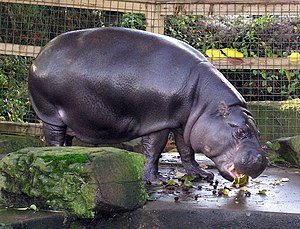Cetartiodactyla
| Cetartiodactyla | ||||||||||||
|---|---|---|---|---|---|---|---|---|---|---|---|---|

|
||||||||||||
| Systematics | ||||||||||||
|
||||||||||||
| Scientific name | ||||||||||||
| Cetartiodactyla | ||||||||||||
| Montgelard et al., 1997 |
The Cetartiodactyla are a taxon (a systematic group) of mammals , which consists of two externally very different groups, the even-toed ungulates (Artiodactyla) and whales (Cetacea). That these two groups form a monophyletic group ( descended from a common ancestor ) has been confirmed by molecular genetic studies and is also morphologically supported by recent fossil discoveries. The artifacts, on the other hand, are now considered paraphyletic because they do not form the sister group as a wholeof the whales, but some representatives - the hippos and probably also the ruminants - are more closely related to the whales than to the other cloven-hoofed animals.
features
The most important synapomorphy (jointly derived feature) of the Cetartiodactyla is the special structure of the ankle bone , which has a joint role at both the upper and lower end. In the past, this was thought to be an exclusive feature of the ungulates, as it did not appear to be present in fossil whales either. (Hind limbs have regressed in modern whales.) In 2001, however, it was discovered that the early fossil whales Pakicetus and Ichthyolestes ( Pakicetidae ), which lived in the late Eocene , also had this special talus.
Two other common features are the three primary lung bronchi and the fibroelastic penis , which means that the erectile tissue is only slightly developed and the erection is primarily brought about by the relaxation of the retractor muscles.
Otherwise, whales and ungulates have taken completely different directions in their evolution. While the whales were probably the marine mammals that were best adapted to the water , the cloven-hoofed animals developed into efficient runners on land who, thanks to their sophisticated digestive systems (especially the ruminants ), adapted perfectly to a plant-based diet.
Systematics
Due to their relatively uniform physique, the ungulates have long been considered a monophyletic group. Since the mid-1990s, however, a series of molecular studies has shown that cetaceans also evolved from cloven-hoofed animals and that hippos are the closest living relatives of whales. As a result and through morphological investigations, the previously suspected descent of the whales from the Mesonychia (a carnivorous ungulate group of the early Cenozoic ) could be refuted.
The oldest fossils of the Cetartiodactyla date from the early Eocene (around 55 million years ago). Since these finds appeared almost simultaneously in Europe, Asia and North America, it is very difficult to determine the place of origin of the ungulates more precisely. These early forms are summarized in the group of Dichobunidae (or Dichobunoidea) - their best known and best preserved representative is Diacodexis . They are small (initially only about the size of a rabbit) with a slim build, long, thin legs and a long tail. The hind legs were significantly longer than the front legs, the typical toe structure was not yet fully developed and the teeth were low-crowned and simply built. Already in the early to middle Eocene there was radiation and the emergence of numerous tribal lines. The oldest whales have been recorded for 53 million years, and the ancestors of the sub-orders of the arthropods ( pig-like , callous soles , ruminants ) emerged in the Eocene.
Only the hippos appeared around 15 million years ago. To explain the 40 million year long gap that this creates (the common ancestor of whales and hippos must have lived before the first whales, i.e. around 55 million years ago), there are indications that the Anthracotheriidae , one from the Eocene to the Pliocene common arthropod group, the sister group of whales and the ancestors of the hippopotamus.
The following suspected lineages result from the recent representatives:
| Cetartiodactyla |
|
||||||||||||||||||||||||||||||
|
|
In December 2007, Hans Thewissen , Professor in the Department of Anatomy at Northeastern Ohio Universities Colleges of Medicine and Pharmacy, presented an alternative family tree hypothesis. According to his research, the closest relatives of the early whales were an extinct cloven-ungulate group called Raoellidae, and both taxa together represent the sister group of the remaining cloven-hoofed animals, including the hippos:
| Cetartiodactyla |
|
||||||||||||
|
|
His findings come from the investigation of a new skeleton from the Kashmir region in Pakistan . It was a representative of the genus Indohyus , which is assigned to the Raoellidae. Mainly due to a bony ring on the temporal bone ( petrosal which was), the so-called involucrum far only known whales, as well as other features of the Vorbackenzähne (premolars) and the bone structure was established the close relationship.
literature
- Thomas S. Kemp: The Origin & Evolution of Mammals . Oxford University Press, Oxford 2005, 331 pages, ISBN 0-19-850761-5 .
- Wilfried Westheide, Reinhard Rieger (Hrsg.): Special zoology. Part 2: vertebrates or skulls . Spectrum Akademischer Verlag, Heidelberg - Berlin 2004, 712 pages, ISBN 3-8274-0307-3 .
Individual evidence
- ↑ Jonathan Geilser and Mark Uhen: Morphological Support for a close Relationship between Hippos and Whales. In: Journal of Vertebrate Paleontology 23 (4): 991-996 (2003).
- ^ Jean-Renaud Boisserie, Fabrice Lihoreau and Michel Brunet: The position of Hippopotamidae within Cetartiodactyla. In: Proceedings of the National Academy of Sciences of the USA 102: 1537-1541 (2005).
- ↑ According to Robin Beck et al .: A higher-level MRP supertree of placental mammals. In: BMC Evol Biol. 2006; 6: 93. PMC 1654192 (free full text).
- ↑ JGM Thewissen, Lisa Noelle Cooper, Mark T. Clementz, Sunil Bajpai, BN Tiwari: Whales orginated from aquatic artiodactyls in the Eocene epoch of India. Nature 450, 2007; Pages 1190-1194.
